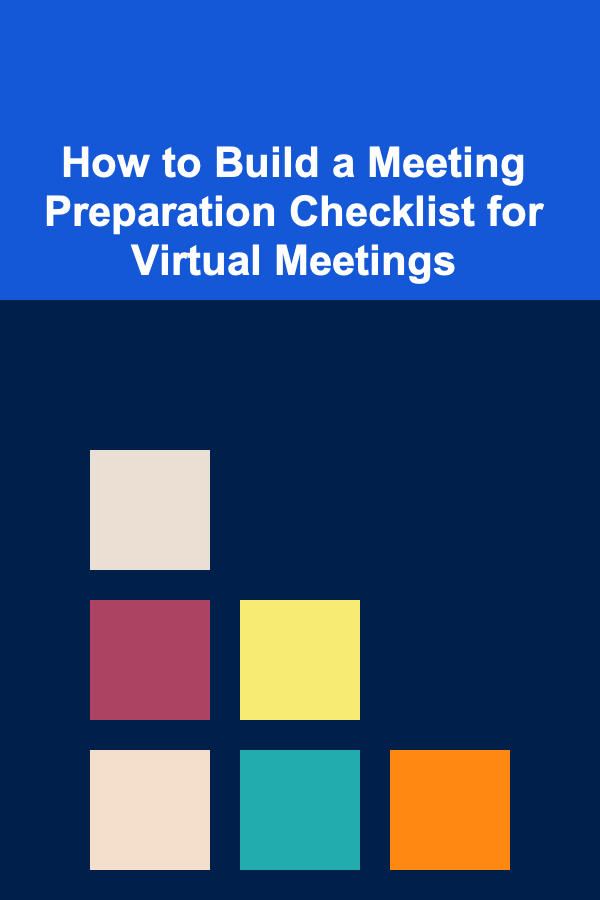
How to Build a Meeting Preparation Checklist for Virtual Meetings
ebook include PDF & Audio bundle (Micro Guide)
$12.99$5.99
Limited Time Offer! Order within the next:

In today's digital age, virtual meetings have become a core part of business operations. Whether you're hosting a team check-in, a client presentation, or a collaborative brainstorming session, the success of a virtual meeting hinges on thorough preparation. To ensure that everything runs smoothly, a meeting preparation checklist is essential.
An actionable checklist serves as a roadmap that ensures all the necessary steps are taken before, during, and after the meeting. Below, we outline the key components for creating an effective meeting preparation checklist for virtual meetings. By following this guide, you can enhance your meeting efficiency, boost productivity, and reduce the likelihood of technical hiccups or logistical missteps.
Define the Purpose and Objectives of the Meeting
Before diving into logistical or technical preparations, the first step in building a meeting preparation checklist is to clarify the purpose and objectives of the meeting. Understanding what you aim to achieve during the session is essential for effective planning and execution.
Steps to Take:
- Identify the primary goal: Is this meeting aimed at decision-making, information sharing, team collaboration, or brainstorming? Knowing the primary objective helps structure the meeting and define how success will be measured.
- Set clear outcomes: Establish tangible outcomes, such as decisions to be made, action items, or next steps. This ensures that everyone leaves the meeting with a clear understanding of their responsibilities.
- Create a focused agenda: Develop an agenda that reflects the purpose of the meeting and breaks down key topics to be discussed. Share it with participants ahead of time to help them prepare.
Select the Right Virtual Meeting Platform
Choosing the right virtual meeting platform is critical for the meeting's success. Different platforms offer varying features, such as screen sharing, breakout rooms, or collaborative whiteboards. Selecting the most appropriate tool ensures smooth interactions and helps achieve meeting objectives.
Key Considerations:
- Participant number: Ensure the platform can accommodate the number of people attending. For larger meetings, tools like Zoom or Microsoft Teams might be more appropriate, while for smaller groups, Google Meet or Skype may suffice.
- Required features: Identify the features necessary for the meeting (e.g., screen sharing, breakout rooms, recording capabilities, chat functionality). Make sure your chosen platform supports these features.
- Ease of access: The platform should be easy for all participants to access. Avoid overly complex tools that may require advanced technical knowledge to operate.
- Security: Ensure the platform you select is secure and allows you to control participant access, share documents safely, and prevent unauthorized disruptions.
Set the Date and Time
Scheduling the meeting at an appropriate time is key to ensuring maximum attendance and engagement. In the context of virtual meetings, scheduling across time zones adds a layer of complexity that needs to be managed carefully.
Best Practices:
- Consider different time zones: Use scheduling tools like Google Calendar or World Time Buddy to find a time that works across various time zones, especially if participants are located globally.
- Check for conflicts: Avoid scheduling conflicts by reviewing the participants' calendars and ensuring there are no overlapping meetings or events.
- Send calendar invites: Once the date and time are set, send out calendar invites with the meeting link, agenda, and any required materials. This ensures all participants are on the same page.
Prepare and Share Meeting Materials
To ensure the meeting runs smoothly and is productive, it's essential to prepare and share all necessary materials well in advance. This enables participants to come prepared and engage meaningfully in discussions.
Action Steps:
- Create a shared folder: Use cloud storage services like Google Drive or Dropbox to create a shared folder where participants can access documents, reports, or presentations before the meeting.
- Send the agenda: Include the agenda along with any key documents and reading materials. This gives participants the opportunity to review and come prepared with questions or comments.
- Prepare presentation slides: If you're presenting, make sure your slides are clear, concise, and visually engaging. Rehearse beforehand to ensure the flow is smooth.
- Assign pre-meeting tasks: If some participants need to prepare reports or updates, communicate these expectations clearly ahead of time and ensure that they are ready to present during the meeting.
Test Your Technology and Tools
Technical glitches are one of the most common disruptions in virtual meetings. To mitigate potential issues, it's essential to test your technology in advance.
Steps to Take:
- Test the meeting platform: Log in to the meeting platform well before the scheduled time to check that everything is working correctly. Verify that your audio, video, and screen-sharing functions are operating as expected.
- Ensure a stable internet connection: A strong internet connection is essential to avoid lagging or disconnects. If possible, use a wired connection for added stability.
- Test the equipment: Ensure that your microphone, webcam, and any other required devices are functioning properly. Check for sound clarity and video quality.
- Check the lighting: Proper lighting helps create a professional and visually clear setup. Make sure you're well-lit, with the light source facing you, not behind you, to avoid shadows.
- Update software: Ensure that the meeting platform and all relevant software (e.g., browsers, apps) are up to date to avoid compatibility issues during the meeting.
Assign Roles and Responsibilities
For a successful meeting, particularly in large groups, it's important to assign roles and responsibilities. Having someone take charge of different aspects of the meeting ensures it runs smoothly and efficiently.
Key Roles to Consider:
- Meeting Host: The host is responsible for starting and managing the meeting, including handling technical issues, welcoming participants, and guiding the agenda.
- Timekeeper: Appoint someone to track time and ensure that the meeting stays on schedule. This is especially important if there are many topics to cover.
- Note-taker: Assign a person to take notes during the meeting. These notes will be essential for summarizing key takeaways and action items.
- Moderator (if needed): If the meeting involves large groups or discussions, a moderator can help facilitate conversation, ensure everyone has a chance to speak, and manage any conflicts or interruptions.
- Tech support: In case of technical difficulties, have a designated person ready to assist participants with troubleshooting.
Prepare for Participant Engagement
Virtual meetings often suffer from disengagement, as participants can become distracted in their home environments. To keep attendees engaged, plan interactive activities and discussion formats that encourage participation.
Strategies for Engagement:
- Polls and surveys: Use built-in polling features in your meeting platform to gather opinions or feedback on specific topics during the meeting.
- Breakout rooms: If your platform supports it, use breakout rooms to encourage smaller group discussions, which can foster deeper collaboration and involvement.
- Q&A sessions: Allow time for a Q&A session, where participants can ask questions or provide feedback on the discussion.
- Use visual aids: Include slides, graphics, or videos to illustrate key points and keep the discussion dynamic.
- Keep discussions focused: Encourage participants to stay on topic and contribute meaningfully to the conversation. This will prevent the meeting from derailing and losing focus.
Prepare for Follow-up Actions
A well-prepared virtual meeting doesn't end when the screen turns off. Follow-up actions are crucial for ensuring that decisions made during the meeting are implemented and that participants remain accountable for any assigned tasks.
Key Follow-Up Steps:
- Send meeting minutes: After the meeting, share detailed meeting minutes, including action items, decisions, and deadlines. This helps clarify expectations and serves as a reference for participants.
- Assign action items : Clearly assign tasks to specific individuals and set deadlines for completion. Use project management tools like Trello, Asana, or Monday.com to track progress.
- Schedule next meeting: If this meeting is part of an ongoing project or initiative, schedule the next meeting to ensure continued progress and alignment.
- Check-in on progress: Set a reminder to follow up on action items and deadlines, either through email or during the next scheduled meeting.
Conclusion
Virtual meetings can be incredibly effective when properly prepared for, but they require meticulous planning and organization. By creating a thorough meeting preparation checklist, you ensure that every aspect of the meeting is covered, from setting clear objectives to testing your technology, keeping participants engaged, and following up afterward. Implementing this checklist will help you run efficient, productive virtual meetings that achieve their intended goals and foster collaboration.
Reading More From Our Other Websites
- [Beachcombing Tip 101] How to Identify and Collect Vintage Bottle Caps While Beachcombing on the Gulf Coast
- [Home Family Activity 101] How to Organize a Family DIY Spa Day at Home
- [Personal Investment 101] How to Stay Informed About Market Trends and News
- [Organization Tip 101] The Best Farmhouse Kitchen Sink Styles for Your Home
- [Home Family Activity 101] How to Organize a Family Charity Event at Home
- [Mindful Eating Tip 101] From Kitchen to Classroom: How Online Mindful Eating Workshops Transform Your Relationship with Food
- [Home Space Saving 101] How to Build a Custom Built-In Bookshelf with Integrated Magazine Storage
- [Home Rental Property 101] How to Handle Rent Collection and Payment Methods Efficiently
- [Metal Stamping Tip 101] From Design to Flight: The End‑to‑End Workflow of Aerospace Metal Stamping
- [Personal Finance Management 101] How to Tackle Student Loan Debt While Maintaining a Balanced Life

How to Handle Property Maintenance Requests During Off-Hours
Read More
How to Make Your Home Comfortable for Senior Pets
Read More
How to Transform Your Media Room into a Sound Proof Sanctuary
Read More
How to Use Decorative Elements to Enhance Your Laundry Space
Read More
10 Tips for Prioritizing Features with Confidence
Read More
10 Tips for Perfect Vegan Indian Cooking
Read MoreOther Products

How to Handle Property Maintenance Requests During Off-Hours
Read More
How to Make Your Home Comfortable for Senior Pets
Read More
How to Transform Your Media Room into a Sound Proof Sanctuary
Read More
How to Use Decorative Elements to Enhance Your Laundry Space
Read More
10 Tips for Prioritizing Features with Confidence
Read More